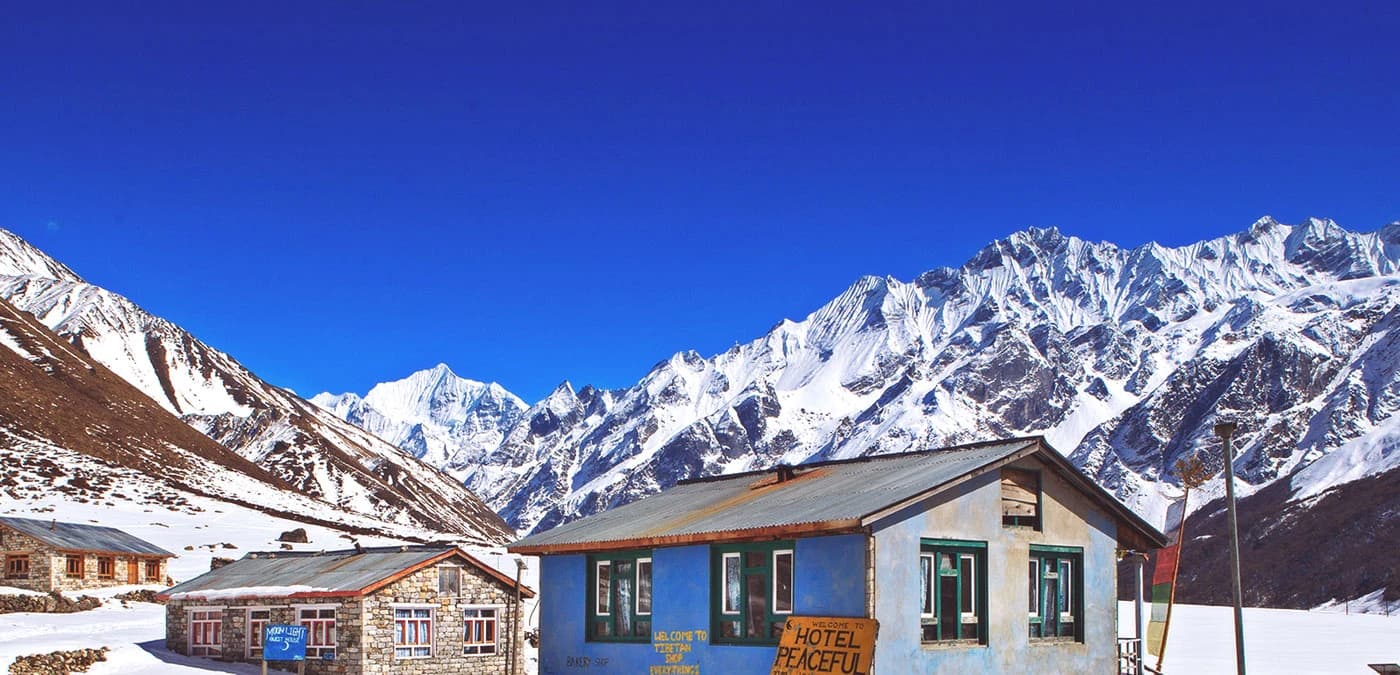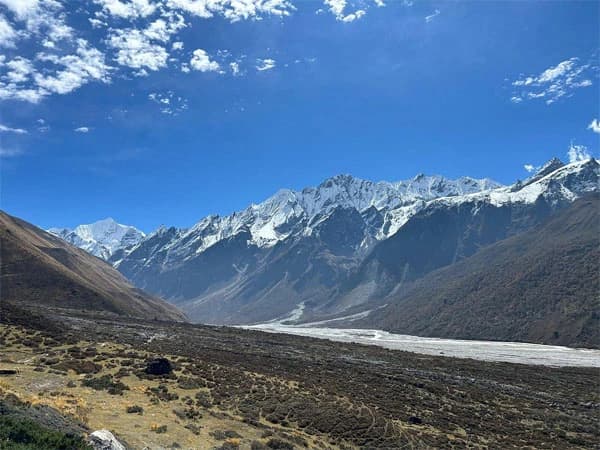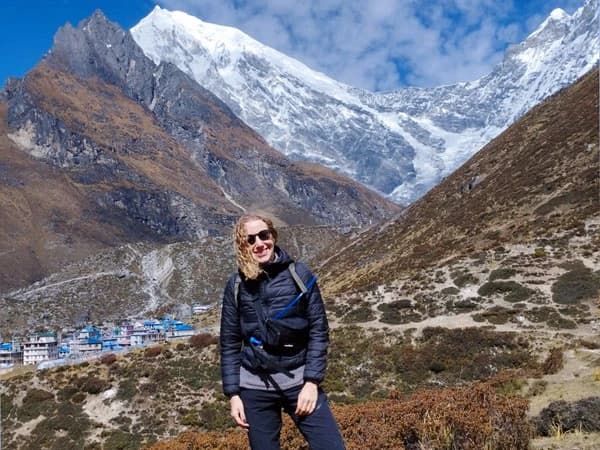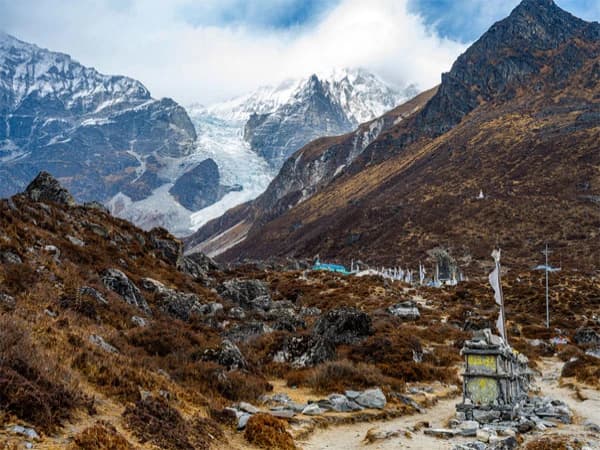Concealed to the north of Kathmandu, Langtang National Park is Nepal’s most fascinating but lesser-known natural gem. Occupying an area of 1,710 square kilometers, it was established in 1976 as Nepal’s initial Himalayan national park. With its 420-square-kilometer buffer zone, the park extends north-south from Rashuwa, Nuwakot, and Sindhupalchowk districts, grazing up against the Tibet border. Although relatively close to the capital city, Langtang is a remote region away with untracked countryside, sacred mountains, rich culture, and paths that wander through forest, glacier, and remote villages.
Langtang National Park
A Topography of Radical Variety
Langtang geography contains radical vertical variety. The park rises from a height of approximately 1,000 meters to over 7,200 meters at Langtang Lirung, the highest elevation in the region. This colossal range of elevation sustains an astonishing variety of ecosystems from subtropical forests with temperate rhododendron and oak forests to alpine pastures along with high Himalayan deserts. The whole park is encircled by an imposing skyline of serrated ridges, glacial streams, steep valleys, and glaciers that follow the curves of the mountain sides. It is the combination of locality that lures trekkers, scientists, and nature lovers in general.
A Mosaic of Flora
Langtang National Park is home to over 1,000 flowering plant species. Sal, chir and pine forests are found at low altitudes; oak, maple, and fir cover the high terrain. During spring the park blooms with rhododendrons i.e. Nepal’s national flower. At higher altitude, the terrain is blanketed with dwarf rhododendrons and junipers, and above 4,500 meters, only hardy grasses and wildflowers will grow. The flowers are not just beautiful, they are also necessary to the grazing animals and the shelter animals.
Wildlife in the Langtang National Park
Langtang contains some of Nepal’s most shy and most endangered wildlife. The most legendary of them all is, the red panda a timid, arboreal animal making a living in the park’s bamboo groves. Langtang also harbors the critically endangered snow leopard, Himalayan black bear, musk deer, Himalayan tahr, ghoral, and the pesky langur monkey. The bird enthusiasts get to see more than 250 species of birds, varying from the beautiful Himalayan monal (Nepal’s national bird), blood pheasants, lammergeyers, and a few varieties of vultures and eagles. Butterflies, pikas, and marmots are also the other animation to this colorful habitat.
Conservation and Community Involvement
Langtang National Park operates under the National Parks and Wildlife Conservation Act of Nepal. Conservation is excellent here in that it involves the people at the grassroots level. There is a buffer zone management for the park, such that local communities help conserve the environment while enjoying a benefit from tourism as well as development activities. Revenue earned through permit is shared partly with the villagers to maintain schools, health posts, and environmentally-sound projects. These organizations are the National Trust for Nature Conservation (NTNC) and WWF Nepal, which have played an active role in conserving Langtang's wildlife, particularly animals such as the snow leopard and red panda.
Climate and Ideal Time to Visit
The climate inside the park is non-even since it supports an altitudinal gradient. The summer is typically warm and wet and the June monsoon continues up to August. Weather will make the topography green but in the process makes the roads slippery and cause landslides. September-November and March-May are the best times for trekking with good weather, moderate temperature, and flowers in bloom. High altitude during winter is severe and cold with the high passes being snowy but lowlands trekking season.
Culture Born to the Himalayas
Langtang is not just all about nature but settled by live hill people. Most of the folks living around and within the park are Tamang, a Tibetan-descended people. They possess their own tradition, attire, language, and faith with Buddhist influences firmly dominant. Mani walls, chortens, prayer wheels, and well-painted monasteries along the trek are visible. Kyanjin Gompa, another of the well-known monasteries close to Kyanjin village, is one of the Langtang Valley trek religious and scenic sights. Rituals, music, and dance follow festivals on days like Lhosar in these villages.
The Earthquake and Rebirth
Langtang was ruined by an overwhelming earthquake in 2015, resulting in a lethal avalanche sweeping through Langtang Village, burning it to ashes and claiming hundreds of lives. The losses were enormous not only just economic and cultural but also human lives. However, the area slowly came back to life through intervention from the government, NGOs, and rebels within the community. Old shacks are replaced with new ones, roads have improved, and life slowly returned to normal. Transportation in the area is a great way of offering healing as well as assessing resilience for those in the Himalayas.
Best Time to Explore Langtang Valley and National Park
The best time to explore the Langtang Valley is during Autumn and spring with favorable weather conditions. Spring offers flower blooms all over the National park adding an extra level of beauty to this region. Surroundings become dry, warm and offer awe-inspiring Himalayan views. Whereas autumn offers clear skies just after monsoon rain clears all the dust in the sky with minimal chances of rainfall and festive vibes. It offers a chance to explore various cultural activities as the main festivals like Dashain and Tihar are celebrated al across the country.
Monsoon and winter season are not favorable time to visit the Langtang national Park as heavy rain causes various disasters like food and landslide at different parts of Nepal and is very risky to travel. Leeches, mosquitoes, and various types of bugs are common during this season. Whereas winter comes with extreme cold in high altitude areas with the chances of heavy snowfall. So it is best to avoid this season.
Permits and documents needed for Langtang National Park
The Langtang National Park authorities has announced Permit mandatory in order to enter the National Park. The Permits needed to enter this region is Langtang National Park Entry Permit and TIMS Card.
Langtang National Park Entry Permit
The cost for this permit depends on the nationality of visitor. The cost for individuals from SAARC country is $15, $30 for other foreign nationals and NPR 100 RS for nepali citizens. This permit was made mandatory in order to enhance the safety of trekkers in the Langtang region.
TIMS Card
TIMS Card is mandatory to trek almost every region in Nepal. This permit can be obtained from the Nepal tourism board in Kathmandu. Cost for this permit varies according to group size and nationality. If you are trekking individually it will cost $20, $10 if trekking in groups and $6 for SAARC nationals.
Major Attractions of the Langtang national Park
Gosainkunda: It is one of the most famous and sacred place for Hindu, Buddhist, and Bon. This pristine lake sits at an elevation of 4380 meters. The trek to Gosainkunda starts from Dhunche which can be reached by taking a bus from the Kathmandu to the headquarter of Rashuwa district i.e. Dhunche. It takes a day or two to reach this sacred lake by foot on mountainous terrain.
Kyanjin Gompa: It is a village in the Langtang region named after 200-300 years old monastery. The altitude of this village is 3870 meters located in Rashuwa district in Nepal. Kyanjin Gompa is one of the main stops during the Langtang Valley Trek.
Tsergo Ri: It is one of the most popular view point accessible from the Kyanjin Gompa (Monastery). It is located at an altitude of 4984 meters offering the awe-inspiring views of mountain peaks like Langtang Lirung, Ganesh Himal, Yala Peak Naya Kang and many more.
Famous treks in the Langtang National Park
Langtang National Park is a trekker’s paradise of all sorts, and the park has treks of all kinds for each trekker. Langtang Valley Trek is the most sought trek, and it usually begins from Syabrubesi and goes on to Lama Hotel, Langtang Village, and on to Kyanjin Gompa. Trekking groups have it most appealing hike to Kyanjin Ri or Tsergo Ri for a panorama of the mountain landscape. For trekkers, Gosainkunda Trek is to sacred alpine lake said to be the home of Lord Shiva. Other alternatives are low-altitude and more culturally rich tamang heritage trail or challenging Ganja La pass trek for the thrill seekers.
Langtang Valley Trek
Langtang valley trek is one of the most famous trek in the Langtang region offering trekkers with beautiful vistas, cultural and traditional diversity. It is shorter and moderately difficult trek near Kathmandu. It is perfect choice for trekkers with limited time wanting to experience roughness of Himalayan lifestyle in Nepal.
Gosainkunda Trek
Gosainkunda Trek in Langtang is a journey to the holy and tranquil lake. This trek is considered moderate due to its high altitude, rough and challenging trekking trails, and limited accessibility of facilities and services. It is sacred and famous among Hindus and Buddhists. Many people visit Gosainkunda during Janai Purnima festival. It is believed that taking a bath in this lake washes away all the sins.
Tamang Heritage Trail
This is a 7-10 days’ trek in the Langtang Region of Nepal offering a chance to immerse yourself in the Tamang culture, traditions, and heritages. This trek offers a chance to interact closely with Tamang people and learn more about their history, beliefs and traditions. This trek helps in supporting the economy of local Tamang communities.
Ganga La Pass Trek
Ganja La Pass trek is one of the most challenging trek in the Langtang region of Nepal. The altitude reaches 5122 meters which demands high physical fitness. Due to its higher elevation the chances for altitude sickness is also high. To go for Ganja La Pass journey careful and crucial preparations are needed.
Conclusion
Langtang National Park is not just a wild life reserve, but a living tapestry of the Himalayan Beauty, culture, traditions, and diversity. It is situated near Kathmandu, but away from the disturbances and facilities if the modern world. It is one of the off the beaten path surrounded by snow-topped peaks, forests, holy lakes, and welcoming tamang and Tibetan villages. Langtang National Park is not just a place but a journey to the rare and pure Himalayan lifestyle. Langtang national park is home to various species of flora and fauna. This national park offers a chance to explore rich Tibetan cultures, scenic natural beauty and various rare animals.





